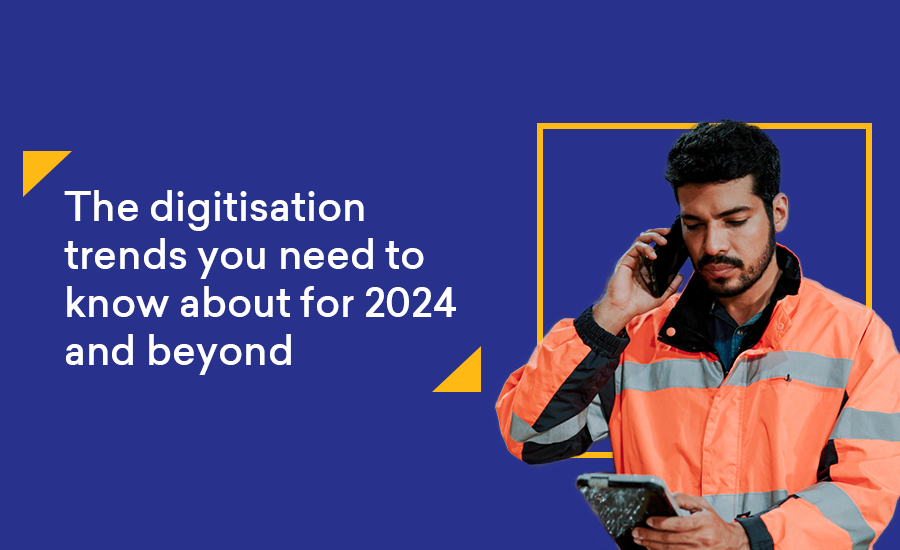The digitisation trends you need to know about in the Queensland public sector for 2024 and beyond

The Queensland Government has committed $200m over the next 3 years to drive a better connected and more inclusive digital future for all Queenslanders. The plan aims to close the digital divide, enable contemporary digital government services, improve connectivity for regional communities, and help business and industries excel, and develop a pipeline of digital talent to grow good, secure jobs for Queenslanders.
77% of government agencies say that digital transformation initiatives during the pandemic had a positive impact (Deloitte)
COVID-19 saw an increase in the digitisation of telehealth, virtual courts, and virtual education, but several years after the pandemic, what's next?
So, what trends are we seeing in the Queensland Public Sector for 2024?
1. A Cloud-first digital strategy, but what does that really mean?
A survey by Relativity found 75 per cent of government agencies anticipate transitioning to cloud in the next three years.
Many government entities are planning a move to ‘the cloud’ for many of their new applications and edge and remote solutions in 2024 and beyond. This decision is driven by the perception that cloud architecture will afford agencies better financial and operational efficiencies and drive innovative solutions to their citizens faster and more effectively. A good example of this is the rise of new AI applications, including generative AI, which will affect many areas in the public sector or remote teaching solutions for our remote and regional communities. For many applications, especially remote, regional and edge solutions, this is very likely true.
However, there is generally no one-size-fits-all solution, and you need to consider multiple interoperable IT solutions to deliver required benefits.
Other considerations would also include availability of mission critical systems; sensitive, personal, or security-based data and data storage; application performance both in the data center, cloud, or at the edge; and any cost and budget implications of the solution. Many government and business entities are starting to reevaluate their cloud strategy due to frequent budget overspending in public cloud environments.
Truis recommendations
- Analyse and scrutinise whether public cloud, private cloud, or on-premises are the right environments for each workload and application in their own right; considering the compliance, risk profile, performance, and cost of each.
- If public cloud is the best fit, be aware of the sprawling cloud costs. Truis can help cloud overspending by working with team to ‘right-size‘ production workloads, allowing for headroom but not over-allocating for inevitable unanticipated usage.
2. Artificial intelligence (AI)
In 2024, government entities must navigate how AI is utilised to boost productivity and efficiency internally, as well as understanding how it may be used by its citizens to enhance connectivity, especially in remote and regional areas. However, whilst AI can bring countless benefits, it also carries many risks if governance and training are not implemented, such as users sharing sensitive company data in generative AI tools such as ChatGPT.
Truis recommendations
- Conduct an audit to see AI tools currently being used and look for unapproved usage, creating a shadow IT.
- The benefits of AI should be considered, but balanced with the strong governance needed to protect confidential data.
- Consider an AI readiness assessment to securely navigate the path to AI.
3. Service delivery
As consumers, we are all used to a one-button click and our order is placed. We are accustomed to the advances in B2C eCommerce to receive personalised experiences; we expect organisations to anticipate our needs, allowing us to enjoy a frictionless user experience. We also want the same omnichannel experience whether we are in-person, on a computer, or using a mobile phone. Citizens will now expect the government to make the same advances as have been made in B2C.
At Truis, we have extensive experience in government and corporate sectors, as well as extensive coverage across the whole of Queensland. When addressing poor user experience, one of the root causes to address is how the performance and customer experience of systems changes between organisations, demographics, and regions.
Truis recommendations
- Identify where service delivery is being impacted and by which systems.
- Identify the highest priority services in need of digitisation in 2024.
- Does your agency or department currently have the IT infrastructure to support further digitisation, or is external help required?
4. Cybersecurity
The Australian government has committed $46.5 million to establish a cybersecurity coordinator in the next four years. This is an important step for cybersecurity within the wider government landscape, but individual organisations are still as responsible as ever for keeping their own networks safe.
Cyber Security strategies need continuous iteration as new and emerging threats emerge.
Ransomware attacks have increased by nearly 500% since the start of the COVID-19 pandemic.
In the event of an attack, restoration time is critical. Despite this, NetApp finds that an alarming 60% of backups are performed incorrectly, and 50% of backups are unsuccessful in restoring data in the event of a disaster.
How Truis helps Queensland government entities navigate to a more digital future
Truis has been at the forefront of Queensland's technology evolution since 1979. Our roots are Queensland-based, through and through. From our origins in the IT equipment trade to our status as a provider of comprehensive technology solutions and managed services, we have consistently demonstrated our commitment to advancing the digital capabilities of government entities across the whole of Queensland from city, to rural and regional areas, to nationwide.
We are not merely implementing technology, but reimagining how government services can be delivered in the digital age. We understand that effective digital transformation in the public sector is not just about technology but also about aligning with the broader goals of public service. Our commitment to sustainability, social responsibility, ethical standards, and economic contribution further aligns with the objectives of modern governance, where environmental stewardship and social impact are prioritised.
Central Highlands Regional Council (CHRC)
Truis' partnership with Central Highlands Regional Council (CHRC) is a testament to our ability to understand a problem, develop a solution, and deliver on that solution.
The CHRC required an upgrade their digital services, however their IT landscape had several proven constraints that was preventing them from reaching their digitisation goals. A new, ground up solution was needed.
Working closely with the team at CHRC, Truis recommended a highly scalable, flexible, and secure hybrid cloud environment to move applications between on-premises and different clouds. A solution that proved not only efficient and strategic, but gave the local government the flexibility and capacity to innovate and grow into the future.
Clinton Nicol-Dickson from the CHRC expressed the value of a partnership-based approach, appreciating Truis' role in enhancing their IT infrastructure and enabling their staff to focus on more strategic tasks.
"We were looking for a true partner – not just a service provider. We wanted to find a vendor who was in it for the right reasons and cared about supporting our council in achieving its strategic objectives."
“Working with Truis really gave us peace of mind "




